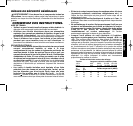
immediately the next time it is plugged in. Damage or injury could
result.
THE VARIABLE SPEED TRIGGER SWITCH permits speed control
– the farther the trigger is depressed, the higher the speed of the drill.
NOTE: Use lower speeds for starting holes without a center punch,
drilling in metal or plastics, driving screws or drilling ceramics. Higher
speeds are better for drilling wood and composition boards, and for
using abrasive and polishing accessories.
THE REVERSING LEVER The reversing lever is used when backing
out screws and jammed drill bits. To operate the tool in reverse,
release the trigger switch and push the lever to the left (when viewed
from the chuck end) as shown in Figure 2. To operate the drill in
forward for drilling holes or driving screws (as well as other
accessories) release the trigger switch and push the lever to the right
(when viewed from the chuck end).
Return the reversing lever to the forward position after all operations
in reverse are completed.
SWITCH LOCK-ON
Your drill is equipped with a switch lock-on feature. If you wish to
disable this feature, take your tool to any authorized service center.
The service center can provide a lock-out key to prevent the unit from
being locked in the “ON” position (Figure 3).
Operation
DRILLING
1. Always unplug the drill when attaching or changing bits or
accessories.
2. Use sharp drill bits only. For WOOD, use twist drill bits, spade bits,
power auger bits, or hole saws. For METAL, use high speed steel
twist drill bits or hole saws. For MASONRY, such as brick, cement,
cinder block, etc., use carbide-tipped bits.
3. Be sure the material to be drilled is anchored or clamped firmly. If
drilling thin material, use a wood “back-up” block to prevent
damage to the material.
4. Always apply pressure in a straight line with the bit. Use enough
pressure to keep drill biting, but do not push hard enough to stall
the motor or deflect the bit.
5. Hold tool firmly to control the twisting action of the drill.
6. IF DRILL STALLS, it is usually because it is being overloaded or
improperly used. RELEASE TRIGGER IMMEDIATELY, remove
drill bit from work, and determine cause of stalling. DO NOT CLICK
TRIGGER OFF AND ON IN AN ATTEMPT TO START A
STALLED DRILL — THIS CAN DAMAGE THE DRILL.
7. To minimize stalling or breaking through the material, reduce
pressure on drill and ease the bit through the last fractional part of
the hole.
8. Keep the motor running when pulling the bit back out of a drilled
hole. This will help prevent jamming.
9. With Variable Speed Drills there is no need to center punch the
point to be drilled. Use a slow speed to start the hole and
accelerate by squeezing the trigger harder when the hole is deep
enough to drill without the bit skipping out.
3
English
FIG. 4
SPINDLE LOCK
BUTTON
Snap-on Drill 11/12/03 8:47 AM Page 3


















